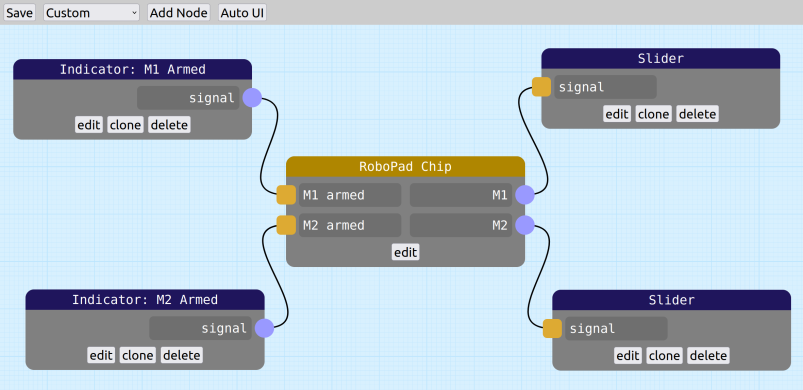Nodegraph Editor: Difference between revisions
No edit summary |
m (Adds image) |
||
| Line 1: | Line 1: | ||
[[File:Node Editor Screenshot.png|thumb|803x803px|The Nodegraph Editor page, displaying the default nodegraph (as of 2023-02-25, [[beta]] build).]] | |||
At the core of the configurability of RoboPad is the Nodegraph Editor. It allows you to specify a control flow from the UI elements that make up your on-screen controller when in <strong>controller mode</strong> all the way to the RoboPad itself. | At the core of the configurability of RoboPad is the Nodegraph Editor. It allows you to specify a control flow from the UI elements that make up your on-screen controller when in <strong>controller mode</strong> all the way to the RoboPad itself. | ||
Every bit of processing that is performed on the node graph is performed on the device you are using to control the robot, meaning that it has minimal impact on the robot's performance. Every time a node is changed - either by it's UI element moving (such as a joystick being moved or a button being pressed), it transmits that change out of it's output ports (golden rounded-squares on the left side of the node), and into the input ports (blue circles on the right side of the node) of any connected nodes. In this way, data can be transformed using different nodes before transmission to the robot itself. | Every bit of processing that is performed on the node graph is performed on the device you are using to control the robot, meaning that it has minimal impact on the robot's performance. Every time a node is changed - either by it's UI element moving (such as a joystick being moved or a button being pressed), it transmits that change out of it's output ports (golden rounded-squares on the left side of the node), and into the input ports (blue circles on the right side of the node) of any connected nodes. In this way, data can be transformed using different nodes before transmission to the robot itself. | ||
If you are looking to start exploring the nodegraph editor, you may want to start with the [[Node Catalogue]] or by taking a look at the [[Nodegraph Examples|Example Nodegraphs]]. | If you are looking to start exploring the nodegraph editor, you may want to start with the [[Node Catalogue]] or by taking a look at the [[Nodegraph Examples|Example Nodegraphs]]. | ||
Revision as of 15:42, 25 February 2023

At the core of the configurability of RoboPad is the Nodegraph Editor. It allows you to specify a control flow from the UI elements that make up your on-screen controller when in controller mode all the way to the RoboPad itself. Every bit of processing that is performed on the node graph is performed on the device you are using to control the robot, meaning that it has minimal impact on the robot's performance. Every time a node is changed - either by it's UI element moving (such as a joystick being moved or a button being pressed), it transmits that change out of it's output ports (golden rounded-squares on the left side of the node), and into the input ports (blue circles on the right side of the node) of any connected nodes. In this way, data can be transformed using different nodes before transmission to the robot itself.
If you are looking to start exploring the nodegraph editor, you may want to start with the Node Catalogue or by taking a look at the Example Nodegraphs.